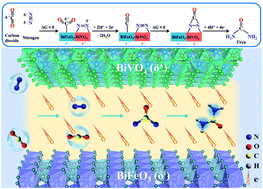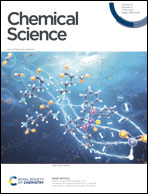Electrochemical C–N coupling with perovskite hybrids toward efficient urea synthesis†
Abstract
Electrocatalytic C–N coupling reaction by co-activation of both N2 and CO2 molecules under ambient conditions to synthesize valuable urea opens a new avenue for sustainable development, while the actual catalytic activity is limited by poor adsorption and coupling capability of gas molecules on the catalyst surface. Herein, theoretical calculation predicts that the well-developed built-in electric field in perovskite hetero-structured BiFeO3/BiVO4 hybrids can accelerate the local charge redistribution and thus promote the targeted adsorption and activation of inert N2 and CO2 molecules on the generated local electrophilic and nucleophilic regions. Thus, a BiFeO3/BiVO4 heterojunction is designed and synthesized, which delivers a urea yield rate of 4.94 mmol h−1 g−1 with a faradaic efficiency of 17.18% at −0.4 V vs. RHE in 0.1 M KHCO3, outperforming the highest values reported as far. The comprehensive analysis further confirms that the local charge redistribution in the heterojunction effectively suppresses CO poisoning and the formation of the endothermic *NNH intermediate, which thus guarantees the exothermic coupling of *N![[double bond, length as m-dash]](https://www.rsc.org/images/entities/char_e001.gif) N* intermediates with the generated CO via C–N coupling reactions to form the urea precursor *NCON* intermediate. This work opens a new avenue for effective electrocatalytic C–N coupling under ambient conditions.
N* intermediates with the generated CO via C–N coupling reactions to form the urea precursor *NCON* intermediate. This work opens a new avenue for effective electrocatalytic C–N coupling under ambient conditions.

- This article is part of the themed collections: Most popular 2021 catalysis articles, 2021 and 2021 Chemical Science HOT Article Collection


 Please wait while we load your content...
Please wait while we load your content...